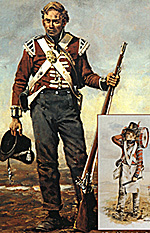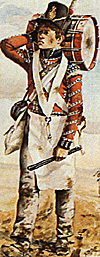Large version of illustration (very slow download: 174K)
As the accompanying article shows, much of the fighting at Hougoumont was done by elements of the three regiments of British Foot Guards. The 1st Brigade, 1st Division was composed of the 1st and 2nd battalions of the 1st Foot Guards. The two battalions were represented at Hougoumont only by their light companies, but they literally made their name later in the day when they played a major part in repulsing the attack of the French Guards on the ridge above. As a result, they were given the name of Grenadier Guards that they bear today.
The two units comprising the 2nd Brigade, 1st Division, were the 2nd battalion, Coldstream Guards, and the 2nd battalion, 3rd Foot Guards (soon to be known as the Scots Guards). All of this brigade fought at Hougoumont, except for small parties left on the ridge above to guard the colors, and perhaps to form a nucleus if the battalions ever needed to reform.
Uniforms
All the Guards regiments had essentially the same uniform, red jackets with the blue facings that denoted a royal regiment. Other than the shako plate, it would not have looked that different from the uniforms of other royal regiments at Waterloo. The most visible difference between the Guards regiments was the arrangement of the buttons and button loops on their jackets. The 1st Guards arranged theirs singly, at regularly spaced intervals. The Coldstreams arranged theirs in pairs, and the Scots Guards in threes.
The British Guards recruited their men directly, and never chose veterans from the line regiments. But the prestige of the Guards gave them great advantages in recruiting; thus, these regiments were usually closer to regulation strength than the line regiments, and the Guards took great pains to get the best physical specimens. Certainly they did not want the "short-arses" commonly seen in lesser regiments.
Prestige
The prestige of the Guards came from their position of being the King's Guards, from their usual post in London, and their socially superior officer corps. Guardsmen could expect to escape dreary colonial postings, unless there was an interesting war, such as the one in the American colonies.
The Guards officer corps was not only truly aristocratic -- only the best cavalry regiments could compare to them in social tone -- but also affluent. During the Napoleonic Wars several Guards officers spent great fortunes maintaining appearances. Being socially higher and better connected, Guards officers had a decided edge in competition for plum staff positions. As a result the battalions were often understrength in officers.
A superb cadre of NCOs compensated for the shortage of officers. If companies of Guards were led by inexperienced and aristocratic lieutenants, the sergeant was always a highly seasoned, long service man. Considered the acme of drill instructors, Guards sergeants were often sent to other infantry corps to teach them how to do it. In fact quite of few of them eventually got commissions, but never, of course, in the socially conscious Guards.
The Guards had performed notably on continental battlefields since their creation. The long list of battle honors in turn served to increase their prestige. Four battalions had served in the Peninsular campaigns at various stages, and had seen hard service, especially in the retreat to Corunna in 1808 and holding the center at Talavera in 1809. Of the four battalions at Waterloo, only the 3rd battalion of the 1st Foot Guards had served in Spain, but veterans were to be found in the other battalions. The Coldstreams had been serving in the Low Countries since 1814.
There were some critical differences between British and French Guards. The French Old Guard infantry, officers and men were selected from the best of the French infantry. French Guard officers were meant to be the finest in their service, and not simply socially superior. The French Guard provided a source of good officers and NCOs to their line counterparts; other than a few drill sergeants, the British Guards only provided an example of military and social graces. The French Guard lured away the best of the line, to a probably pernicious degree, while the British Guards, on the other hand, would never have accepted them.
The French and British Guards were also utilized differently in battle. The French Old Guard infantry was usually retained as final reserve, while the British Guards often served their turn in the front line like any other unit. As they were in combat more often, sometimes in tough spots, British line units were somewhat accustomed to seeing the Guards fighting, and if necessary running, as they did at Talavera.
When the French Middle Guard were repelled in the final assault on the ridge at Waterloo, it had a shattering effect on the French army. The rout of the British Guards at Talavera, on the other hand, had not caused general demoralization. While the French Guard was the idol of the French soldier, and his desired post was in its ranks, this simply was not true in the British army. Common British soldiers could not aspire to join the Guards. Many British units at Waterloo thought they were as good, if not better than the Guards. The 52nd Light Infantry, the Black Watch, and Gordon Highlanders certainly did, as well as tough regiments like the 44th and 71st. The Guards were seen as first among equals, not the elite of the army, and many British soldiers ridiculed the social pretensions of the Guards mercilessly.
So, what would have happened if the British Guards had been routed at Waterloo? Perhaps the same as was alleged at Alma in 1854 in Queen Victoria's time, in a story that is perhaps apocryphal. As the Scots Fusilier Guards were sent reeling down the ridge by a Russian counterattack, the line units around are said to have cried, "Where are the Queen's pets now?" and eagerly went into the attack.
Hougoumont
This article appears in MagWeb (Magazine Web) on the Internet World Wide Web. In December 1813 Wellington felt it necessary to issue a rebuke to his Foot Guards. The subject was umbrellas: "The Guards may in uniform, while on duty at St. James's, carry them if they please; but in the field it is not only ridiculous but unmilitary." It is difficult to imagine Napoleon having to send a similar order to his Imperial Guard.
In December 1813 Wellington felt it necessary to issue a rebuke to his Foot Guards. The subject was umbrellas: "The Guards may in uniform, while on duty at St. James's, carry them if they please; but in the field it is not only ridiculous but unmilitary." It is difficult to imagine Napoleon having to send a similar order to his Imperial Guard.
What were these Guards like?
 Naturally people tend to compare the British Guards with the French Imperial Guard, and the British Grenadier Guards did defeat some of their counterparts late in the day at Waterloo. But there are as many differences as similarities between the two forces.
Naturally people tend to compare the British Guards with the French Imperial Guard, and the British Grenadier Guards did defeat some of their counterparts late in the day at Waterloo. But there are as many differences as similarities between the two forces.
Guards: French vs. British
Introduction
First and Second French Assaults
More French Assaults
In Retrospect (analysis)
Hougoumont Today
French Line Grenadier (profile)
British Foot Guards (profile)
Excerpt from Lt. Ellison, 1st Foot Guards
Order of Battle
Diorama
Back to Table of Contents -- Napoleon #7
Back to Napoleon List of Issues
Back to Master Magazine List
© Copyright 1997 by Emperor's Press.
The full text and graphics from other military history magazines and gaming magazines are available at http://www.magweb.com